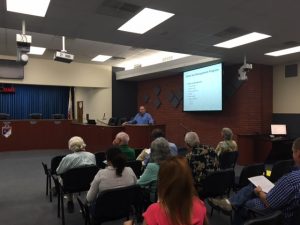
Bruce Wilcox, Assistant Secretary for Salton Sea Policy for the California Natural Resources Agency, presents the State’s Salton Sea Management Program phase one during a public workshop held at the Imperial Irrigation District auditorium in El Centro on June 16.
If you have an interest in learning about the steps the State is taking to address Salton Sea issues, it would be worth attending at least one of a series of community workshops being held almost weekly throughout this summer led by Bruce Wilcox, Assistant Secretary for Salton Sea Policy for California Natural Resources Agency. Working with a Salton Sea Task Force outreach advisory committee, Wilcox has organized these public workshops to introduce what is being touted as Phase One of the State’s Salton Sea Management Program.
Since May, workshops have been held at venues in Imperial County, Riverside County, and will be held in Los Angeles and San Diego later this summer. On June 16, a workshop was held at the Imperial Irrigation District auditorium in El Centro. A week earlier, a similar workshop was held in Calexico at the cultural arts center. This week, on June 23, a workshop was held in Irvine, and then on June 30 there will be a workshop at the Coachella Valley Water District board room.
The workshops return to the Valley on July 7 with one to be held from 5:30 to 7:30 at Ski Inn at Bombay Beach, and then from 5:30 to 7:30 p.m. July 14 at the Calipatria City Hall, and July 21, at the Westmorland City Hall, again from 5:30 to 7:30 p.m.
These community discussions are meant to both share information on the Salton Sea Management Program and address questions and concerns the community may have. The State is also interested in hearing what kind of projects are most important to residents. Community input is essential to the success of the Management Program. After years of what many have viewed as inaction at the Sea, momentum now seems to be building toward a feasible restoration effort at the Sea—one led by the State. Some of the phase one projects are set to begin construction in 2017.
There is a lot of attention in the media given to the end of mitigation flows to the Salton Sea come 2018. What needs to be understood is that a great deal of water will still flow to the Sea from agricultural run-off with current estimates at about 750,000 acre-feet of inflows continuing to the Sea. While that is less than what currently flows to the Sea, a great deal can be done with that amount of water to protect human health as the main priority but also to ensure there is habitat for the migratory birds that depend on the Salton Sea as part of their Pacific Flyway. It all comes down to how the State manages that water. The idea here is to have a smaller but sustainable Sea with human health and habitat protected by a series of incremental projects.
It is true that funding remains the biggest challenge. The Water Authority and its water partners on the Quantification Settlement Agreement Joint Powers Authority (QSA JPA) are providing $67 million in seed money to kick-start restoration projects. That funding has mixed with Proposition 84 dollars into a Salton Sea Restoration Fund. More recently the State approved $80.5 million for the Sea from Proposition 1 dollars and the Bureau of Reclamation approved $3 million in federal funding for a wetlands project along the Alamo River that will aid water quality at the Sea. But more funding is needed and the Water Authority and all stakeholders in the Sea will continue to lobby for the State and Federal governments to provide additional allotments of funding for Sea projects.
On a separate note, the QSA JPA funding partners—the Water Authority, the Imperial Irrigation District and Coachella Valley Water District—are providing $287 million in funding for mitigation projects related to the QSA, with the greatest portion of the funding for the Sea. That money is paying for air quality projects at the Sea that will help address potential dust emissions that relate to the QSA once mitigation flows end. Pilot versions of these projects are underway now to determine what projects work best. The State, which is also a partner in the JPA, has a responsibility to fund mitigation projects—separate from restoration—that exceed the $287 million provided by the water agencies.
During the workshops, Wilcox provides an update on these mitigation projects along with discussing the Salton Sea Management Program. If you have a chance, you are urged to attend one of these workshops. You can also learn more about the State’s efforts at the website California Natural Resources Agency has set up for the management project. You can find it here: http://resources.ca.gov/salton-sea/
